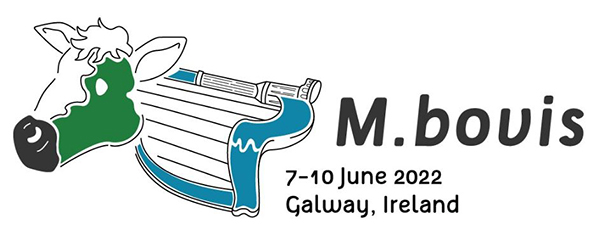Advances in the antibody-based diagnosis of caprine tuberculosis: Milk as an alternative sample
Oral communication in Seventh International Conference on Mycobacterium bovis
June 9th, 2022
Ortega J., Roy A., Romero B., de Juan L., Infantes-Lorenzo JA., Dominguez M., Dominguez L. and Bezos J.
Objective: caprine tuberculosis (TB) is a zoonosis caused by members of the Mycobacterium tuberculosis complex (MTBC), mainly M. bovis and M. caprae, with sanitary and economic impact. Caprine TB control programs, where they exist, are mainly based on a test and cull strategy using the intradermal tuberculin tests and slaughterhouse surveillance. However, this approach is not always feasible and may have a limited sensitivity under specific circumstances. Therefore, serological tests have been proposed as potential diagnostic tools to maximize the detection of infected animals and/or for herd screening using both serum and plasma samples. Additionally, milk has been proposed as an alternative sample to detect specific antibodies (Ab) against the MTBC. The objective of this study was to evaluate the performance of an experimental Ab-based test for TB diagnosis in goats using serum and milk samples.
Key findings: individual serum and milk samples from low and high prevalence TB-infected caprine herds were assayed using an indirect ELISA that detects Ab against a protein complex purified from bovine Purified Protein Derivative (CZV, Spain) named P22, (P22 ELISA) and results were compared with those obtained using cell-based diagnostic tests. A similar sensitivity using serum and milk samples was detected, suggesting the usefulness of milk samples as an alternative for TB diagnosis in dairy herds. Moreover, bulk milk tank samples from both herds were analyzed using P22 ELISA to evaluate its usefulness as herd screening, suggesting that reactivity is highly correlated to the herd prevalence. In order to evaluate the Ab levels in milk during the lactation period and determine whether time of sampling may affect the results, goat milk samples (n=44) from a high TB prevalence dairy herd were collected every 4 weeks during 6 months and assayed using P22 ELISA, showing no significant variations (p=0.079) throughout the study in terms of Ab levels in milk samples between consecutive analyses. Nevertheless, reactivity to P22 ELISA decreased when samples were collected the last two months (fifth and sixth) of the lactation period compared to initial stages.
Impact of study: the present study suggests that milk samples are valuable for Ab-based diagnosis of TB in caprine dairy herds and that the reactivity to P22 ELISA can decrease when samples are collected at the final stages of the lactation period. Moreover, bulk milk tank samples could be valuable to define the herd status.
Objective. Real-Time PCR is considered a promising technique in the detection of Mycobacterium tuberculosis complex (MTBC) species in bovine tissue samples as it is a sensitive and specific method that yields results in a reduced period of time and is not subjected to the limitations of microbiological culture. The objective of this study was to evaluate the diagnostic performance of two Real-Time PCRs based on the IS6110 and mpb70 molecular targets in the detection and quantification of MTBC DNA.
Key results/findings. Nine-hundred and eighty-five (IS6110) and 200 (mpb70) bovine tissue samples were processed and analysed in parallel through microbiological culture and Real-Time PCR. When compared to culture, diagnostic sensitivity was 96.78% (95% CI: 94.46% - 98.15%) for the IS6110 PCR and 89.19% (95% CI: 79.80% to 95.22%) for the mpb70 PCR, whereas diagnostic specificity was 99.02% (95% CI: 97.88% - 99.55%) and 96.03% (95% CI: 90.98% to 98.70%), respectively. Minor cross-reactivity was detected for the IS6110 PCR against a reduced number of Mycobacterium avium subsp. hominissuis isolates. Diagnostic performance of the IS6110 PCR was moderate and very high in samples with non-visible and visible lesions, respectively.
Significance/Impact of study. The Real-Time PCRs presented here show high diagnostic performance when compared to culture, indicating that they are suitable as first-line techniques in the detection of MTBC species in bovine tissue samples. The single-copy nature of the mpb70 makes it also an appealing quantification technique with multiple applications. The high performance of the IS6110 PCR in samples with visible lesions makes this method an alternative to culture in this type of samples
 | Servicio de Micobacterias (MYC). Centro de Vigilancia Sanitaria Veterinaria (VISAVET). Universidad Complutense (UCM). |
 | Departamento de Sanidad Animal. Facultad de Veterinaria. Universidad Complutense (UCM). |
| BIOFABRI, S.L.. | |
| Servicio de Inmunología. Centro Nacional de Microbiología (CNM). Instituto de Salud Carlos III (ISCIII). | |
Link to Seventh International Conference on Mycobacterium bovis


